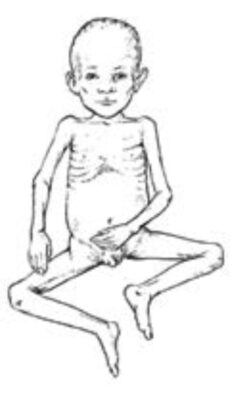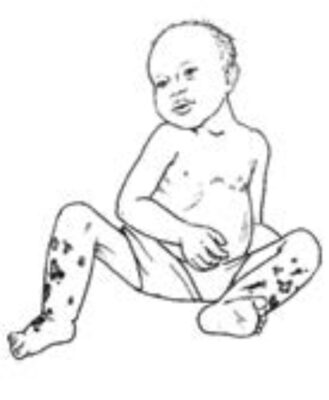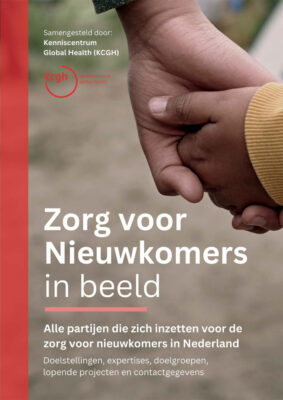Main content
Climate change is becoming a more and more pressing issue for global health. Increasing greenhouse gas emissions contribute to global warming, extreme weather emergencies and natural disasters like droughts, earthquakes, hurricanes and floods. [1,2] In addition to the direct health impact of these disasters, the indirect effects on air and water quality, crop failure, lack of shelter and transmission of infectious diseases also endanger human health worldwide. [1,2,3] Common health issues caused and worsened by the above mentioned are for instance malaria, diarrhoeal disease, heat stress and malnutrition; it is expected by the World Health Organization (WHO) that these alone will cause an extra 250.000 annual deaths between 2030 and 2050. [3] Next to these, mental health problems, cardiovascular and respiratory diseases are common threats to human health, and are also increasing following climate change. [2] Low-income countries, although contributing least to global emissions, endure the worst health impacts. [3]
Malnutrition
The WHO and the Intergovernmental Panel on Climate Change estimate that malnutrition will be the largest contributor to climate change related morbidity and mortality. [1] Malnutrition indicates all problems with nutrient intake, ranging from deficiencies and excesses to imbalance that can cause undernutrition as well as obesity and other diet related diseases. Undernutrition can present as wasting, stunting, underweight or micronutrient deficiencies. [4,5] Malnutrition can have long term effects on a person’s life, therefore early treatment is necessary.
The WHO defines severe acute malnutrition (SAM) as [6]
- Severe wasting, meaning a weight for height with a Z-score¹ of <-3SD or a mid-upper arm circumference of <115mm².
Or - Bilateral oedema of the lower extremities (due to malnutrition), this can be with or without severe wasting.
For the treatment of SAM there is no distinction made for Kwashiorkor or Marasmus since the treatment of both conditions is almost similar. [6] Children with complicated SAM, meaning loss of appetite or any medical complications (including oedema), require in-hospital treatment. With severe social problems an in-hospital treatment should be considered. Children that are stunted (often the irreversible result of chronic undernutrition) may be underweight but are not necessarily severely wasted (often the result of more recent severe weight loss). These children, although chronically malnourished, do not need in-hospital treatment, unless severely ill. [4,6]
| Definitions Wasting: Low weight for height [4] Stunting: Low height for age [4] Underweight: Low weight for age [4] Marasmus: Severe malnutrition with wasting of adipose tissue and muscles. (Fig 1) [6] Kwashiorkor: Severe malnutrition with bilateral (lower extremity) oedema. (Fig 2) [6] |


The in-hospital treatment of sam in children – a short recap
This is a short recap of the (WHO) guidelines concerning the treatment of severe acute malnutrition. All treatment information (including drug dosage) is available (free of charge) through the described sources.
The treatment of SAM is divided into different stages.
- Initial triage, assessment and treatment (0-12 hours) [6,8]
Triage and treat emergency signs according to ETAT standards.- Treat acute airway and breathing problems.
- Airway manoeuvres, oxygen.
- Treat shock (hypovolemia, anaemia, sepsis) in malnutrition.
- DRL5/DNS5³, whole blood, ReSoMal⁴, (antibiotics, antimalarials).
- Treat coma and convulsions.
- D10⁵, diazepam, phenobarbital.
- Treat dehydration in malnutrition.
- ReSoMal, later alternated with Formula-75 (F75).
Further investigations include: [6,9]
- ReSoMal, later alternated with Formula-75 (F75).
- Assessment of the patient’s current danger signs
- For instance: appetite, diarrhoea, vomiting, coughing, fever.
- Assessment of the patient’s history
- For instance: diet, recent intake, breastfeeding, vaccinations, social circumstances, measles, tuberculosis (TB), HIV.
- Full physical examination
- Pay special attention to: oedema, vit A deficiency, infection, oral/skin lesions.
- If possible; lab investigation
- Glucose, full blood count, urine analysis, screen for infection (HIV, TB, Malaria).
When initial assessment and treatment is done, move on to stabilisation of the patient.
- Glucose, full blood count, urine analysis, screen for infection (HIV, TB, Malaria).
- Treat acute airway and breathing problems.
- Stabilisation (2-6 days) [6,9]
The initial refeeding phase should restore metabolism and should be taken slowly.- Start with F75 according to WHO schedule; 130ml/kg/day.
- Start on 2 hourly feeds, if the patient maintains this (<5 vomiting/diarrhoea, good appetite) expand to 3 or 4 hourly feeds.
- Breastfeeding can be continued in addition to the refeeding schedule.
- Insert nasogastric tube if the intake is <80% (two consecutive feeds).
- Initial refeeding can cause vomiting and/or diarrhoea.
- Replenish continuous losses with ReSoMal.
- In recurrent vomiting/diarrhoea it is possible to alternate F75 with ReSoMal.
- Age <6 months:
- Give expressed breast milk, infant formula, infant F75 or diluted Formula-100 (F100) according to WHO standards.
- In patients with severe oedema:
- Start F75 according to WHO schedule; 100ml/kg/day.
- Always beware of hypoglycaemia, hypothermia, dehydration, congestive heart failure and infections and treat accordingly.
- All patients with malnutrition have a shortage of electrolytes (sodium, potassium) and micronutrients (vitamin A, zinc, copper, folic acid).
- These ingredients are implemented in F75, F100 and RUTF⁶ and are not necessary to replenish.
- Only when signs of vitamin A deficiency (corneal ulceration, history of measles) give extra vitamin A on day 1, 2, and 14.
- Only start iron suppletion after stabilisation phase, and not when patient is on RUTF.
- Suppletion of electrolytes and micronutrients is necessary only when a patient is not on premixed food⁷.
- Limited to no weight gain can be normal during stabilisation.
- If a patient fails to respond to treatment:
- Reassess, reconsider the diagnosis and consult a senior.
Improvement (return of appetite, no hypoglycaemic events, reduction/disappearance of oedema) normally shows within a few days. The patient can then move on to transition and rehabilitation.
- Reassess, reconsider the diagnosis and consult a senior.
- Start with F75 according to WHO schedule; 130ml/kg/day.
- Transition (2-3 days) and Rehabilitation (indefinitely) [6]
Entails ‘catch up growth’ after a period of malnutrition.- Start with a gradual transition from F75 to RUTF (or F100).
- RUTF dosage of 175-200kcal/kg/day.
- Start with 8 meals, decreasing to 5-6 meals per day.
- Complement with F75 if the full amount is not eaten.
- When consuming <50% RUTF in 12 hours, go back to F75. Retry in 1-2 days.
- When age <6 months return to breastfeeding (complemented with formula if necessary).
- Stimulate physical activity, tender, love and care.
- Discharge
- When the patient is fully transitioned to RUTF, when medical complications (including oedema) have resolved and appetite has returned.
- Restart family meals in addition to breastfeeding and RUTF.
- Treat empirically for parasitic worm infections.
- Refer the patient to outpatient rehabilitation for weekly review and weight measurement.
When a patient in outpatient rehabilitation shows weight loss, poor weight gain or medical complications reassess and readmit to hospital if necessary.
- Start with a gradual transition from F75 to RUTF (or F100).
Need for action
Climate change contributes to a higher number of malnourished children. Given the direct and long-term consequences of malnutrition on human health, there is a need for urgent action. The WHO responds to these challenges by for instance: promoting actions to reduce carbon emissions, building climate and environmentally sustainable health systems, trying to protect human health from the impact of climate change, creating awareness, partnering with health agencies, collecting health data and collaboration and support of health ministries worldwide. Together, these measures try to create climate resilient and low carbon emission health systems. [3]
Interested? Find more information on the website www.who.int/health-topics/climate-change
¹ The severity of malnutrition can be classified by looking at the ‘Z-score’. This system scores the number of standard deviations from the median value to classify the amount of wasting, stunting or underweight as severe, moderate or mild [7]
² Usable for an age above 6 months
³ Dextrose 5% + ringer’s lactate/normal saline
⁴ Rehydration Solution in Malnutrition
⁵ Dextrose 10%
⁶ Ready-to-Use Therapeutic Food
⁷ Recipes for F75, F100, catch-up meals and ReSoMal available through
References
- Mark Lieber, Peter Chin-Hong, Knox Kelly, Madhavi Dandu, Sheri D. Weiser. A systematic review and meta-analysis assessing the impact of droughts, flooding, and climate variability on malnutrition. Global Public Health 2020, Dec;17(1):68-82.
- Ki-Hyun Kim, Ehsanul Kabir, Shamin Ara Jahan. A Review of the Consequences of Global Climate Change on Human Health. Journal of Environmental Science and Health, Part C, 2014;(32:3):299-318
- WHO. Fact sheet climate change and health. [Internet]. Available from: https://www.who.int/news-room/fact-sheets/detail/climate-change-and-health [Accessed 5th November 2023].
- WHO. Health topics – malnutrition. [Internet]. Available from: https://www.who.int/health-topics/malnutrition#tab=tab_1 [Accessed on 5th of November 2023]
- WHO. Fact sheet malnutrition. [Internet]. Available from: https://www.who.int/news-room/fact-sheets/detail/malnutrition [Accessed 5th November 2023].
- WHO team. Pocket book of hospital care for children: guidelines for the management of common childhood illnesses. 2nd edition. Geneva. WHO press, 2013. Also available through [Internet]: https://www.who.int/publications/i/item/978-92-4-154837-3
- WHO. Tools. Child growth standards. [Internet]. Available from: https://www.who.int/tools/child-growth-standards/standards/weight-for-length-height [Accessed 5th November 2023].
- WHO. Emergency Triage Assessment and Treatment course manual. [Internet]. Available from: https://www.who.int/publications/i/item/9241546875 [Accessed 5th November 2023].
- Queen Elizabeth Hospital Blantyre. Paediatric guidelines malnutrition. [Internet]. Available from: https://www.openguidelines.net/data/set_1000/html/malnutrition.htm [Accessed 4th November 2023]


















































